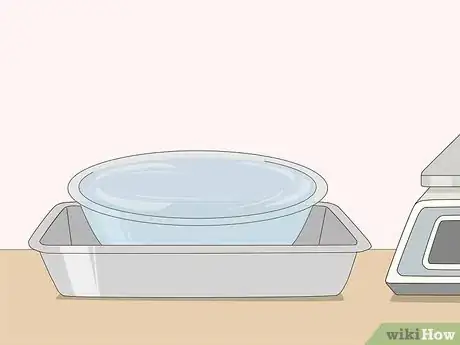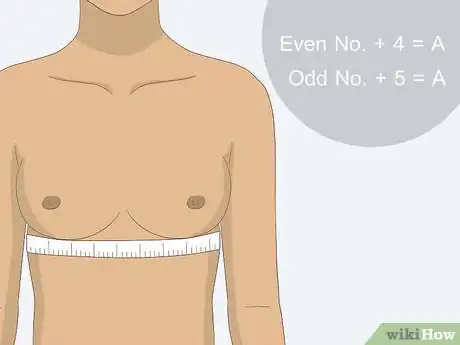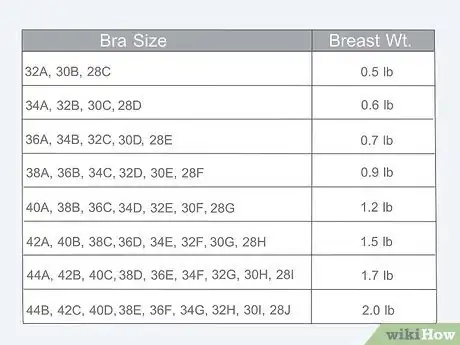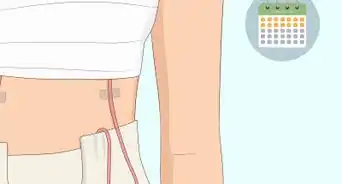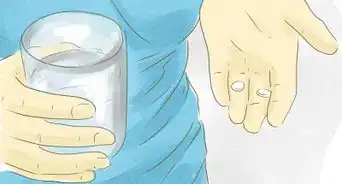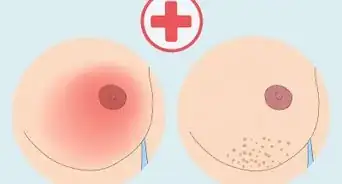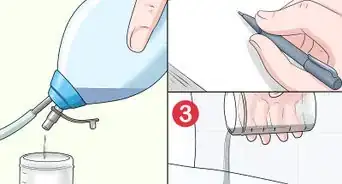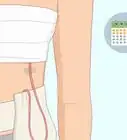This article was medically reviewed by Sarah Gehrke, RN, MS and by wikiHow staff writer, Megaera Lorenz, PhD. Sarah Gehrke is a Registered Nurse and Licensed Massage Therapist in Texas. Sarah has over 10 years of experience teaching and practicing phlebotomy and intravenous (IV) therapy using physical, psychological, and emotional support. She received her Massage Therapist License from the Amarillo Massage Therapy Institute in 2008 and a M.S. in Nursing from the University of Phoenix in 2013.
There are 7 references cited in this article, which can be found at the bottom of the page.
This article has been viewed 808,504 times.
Whether you’re preparing for a breast surgery or just curious, it can be useful to know how much your breasts weigh. Unfortunately, finding the answer isn’t usually as easy as putting your breasts on a kitchen scale. You can get a rough estimate by displacing some water with your breasts, or make an educated guess based on your bra size. If you need a more accurate weight estimate, your doctor may be able to help.
Steps
Using the Displacement Method
-
1Get a tray, a large bowl, and a kitchen scale. To estimate your breast weight using this method, you’ll be measuring the weight of water displaced by your breasts. Start by getting a bowl that’s big enough to completely submerge one of your breasts as well as a deep tray or baking dish. You’ll use the tray to catch the displaced water from the bowl. You’ll also need an accurate scale for measuring relatively small weights, such as a kitchen scale.
- A small bucket or cooking pot should also work if you don’t have a bowl that you can easily fit one of your breasts into.
-
2Weigh the empty tray on a kitchen scale set on ounces. Since you need to determine the weight of the water that spills into the tray, get the weight of the empty tray first. After you weigh the displaced water, you’ll need to subtract the weight of the tray to get an accurate weight.
- Use a scale that can measure in ounces and fractions of ounces. This will help you get a more accurate weight than if you used larger units of measurement, like pounds.
- Write down the weight of the tray so that you don’t forget it!
-
3Fill the bowl with water to the brim while it’s on the tray. After you weigh the tray, set it down on a level surface and put the bowl in the middle of the tray. Fill your bowl with water all the way up to the brim so that some of the water will spill out when you lower your breast into it.
- For your own comfort, you may wish to use warm water.
-
4Submerge 1 breast in the bowl of water. After you fill the bowl, position yourself over the bowl and tray and slowly lower 1 breast into the bowl. Lean forward enough so that your entire breast is submerged in the water. You may need to rest your ribcage very lightly on the rim of the bowl, but try not to push down too hard so you don’t accidentally displace excess water.
- Some of the water should spill over the sides of the bowl into the tray.
- Do this without a bra on so that the bra won’t absorb water and interfere with the measurement.
Tip: This method is easiest if you have relatively large or droopy breasts but not a lot of abdominal fat. To get an accurate result, you need to be able to get your entire breast into the container without dipping any of your belly into the water as well.[1]
-
5Measure the weight of the displaced water in the tray. When you’re done, carefully lift your breast out of the bowl and remove the bowl from the tray. Put the tray with the displaced water in it on your kitchen scale. Subtract the weight of the tray from the result.
- Be careful not to spill any of the water from the tray when you move it onto the scale.
- For example, if you get a result of 25.3 ounces (720 g) and your tray weighed 3.2 ounces (91 g), subtract 3.2 ounces (91 g) from 25.3 ounces (720 g). The resulting weight of the water is 22.1 ounces (630 g).
-
6Multiply the weight of the water by 0.9. Since breast tissue and water have slightly different densities, they won’t weigh exactly the same amount. You can convert the weight of the water to a closer approximation of your breast weight by multiplying it by 0.9.
- For example, if the displaced water weighs 35 ounces (990 g), multiply that by 0.9 to get 31.5 ounces (890 g). That is the approximate weight of your breast.
- To convert ounces to pounds, divide the weight in ounces by 16. For the previous example, divide by 31.5 ounces (890 g) by 16, which is equal to 1.97 pounds (0.89 kg).
-
7Repeat the process with your other breast. Once you’ve estimated the weight of one breast, repeat the process with the other one. Since most people’s breasts are not exactly equal in size, you’re likely to get 2 slightly different results.
- To get the most accurate possible results, try weighing each beast 2-3 times to make sure you get a consistent measurement each time.
Estimating Your Breast Weight Based on Cup Size
-
1Find out your band size. To estimate your breast weight based on your bra size, you’ll need an accurate idea of what your bra size is. This means figuring out both your band size and your bust size, then using the difference to find your cup size. Start by wrapping a fabric measuring tape around your ribcage just under your breasts. Round the measurement up to the nearest whole number. Add 4 if the resulting number is even or add 5 if it’s odd.[2]
- For example, if the measurement you get is 30 inches (76 cm), add 4 to get your band size of 34.
Keep in mind: Bras are sized differently from one country to another, and measurements also vary between individual manufacturers. This technique will help you estimate your breast weight based on U.S. bra sizes from a few of the most common bra brands.
-
2Measure your bust size. Next, wrap the measuring tape around your breasts at the fullest point, just over the nipple. Round up the result to the nearest whole number. This measurement will give you your bust size.[3]
- For example, if you get a measurement of 35.6 inches (90 cm), round it up to 36 inches (91 cm).
- It’s best to do this without a bra on so that you get an accurate measurement.
-
3Subtract your band size from your bust size to calculate your cup size. Your cup size is based on the difference between your band size and your bust size. The bigger the difference, the larger your cup size is.[4] For example:
- If the difference is 0 inches (0 cm), you are an AA cup.
- If the difference is 1 inch (2.5 cm), you are an A cup.
- If the difference is 2 inches (5.1 cm), you are a B cup.
- If the difference is 3 inches (7.6 cm), you are a C cup.
- If the difference is 4 inches (10 cm), you are a D cup.
- If the difference is 5 inches (13 cm), you are a DD or E cup.
- If the difference is 6 inches (15 cm), you are a DDD or F cup.
- If the difference is 7 inches (18 cm), you are a G cup.
- If the difference is 8 inches (20 cm), you are an H cup.
- If the difference is 9 inches (23 cm), you are an I cup.
- If the difference is 10 inches (25 cm), you are a J cup.
- Alternatively, you can find your cup size by filling in your measurement info using an online bra size questionnaire. Use search terms like “bra fit quiz.”
-
4Put your band size and cup size together to get your bra size. Once you know both your band size and your cup size, combine them to get your bra size. For example, if you have a band size of 34 and a B cup, you’re a 34B.[5]
- If you’d rather not do all the measurements yourself, you can also go to a lingerie store and get a professional fitting.
-
5Find the approximate weight that corresponds to your bra size. Once you know your bra size, you can estimate the weight of each breast by consulting the chart below. Keep in mind that this method provides a very rough estimate, and does not take into account the natural differences in weight between each breast. It also doesn’t account for the variations in breast density from one person to another.
- 32A, 30B, 28C: approximately 0.5 pounds (0.23 kg) per breast
- 34A, 32B, 30C, 28D: approximately 0.6 pounds (0.27 kg) per breast
- 36A, 34B, 32C, 30D, 28E: approximately 0.7 pounds (0.32 kg) per breast
- 38A, 36B, 34C, 32D, 30E, 28F: approximately 0.9 pounds (0.41 kg) per breast
- 40A, 38B, 36C, 34D, 32E, 30F, 28G: approximately 1.2 pounds (0.54 kg) per breast
- 42A, 40B, 38C, 36D, 34E, 32F, 30G, 28H: approximately 1.5 pounds (0.68 kg) per breast
- 44A, 42B, 40C, 38D, 36E, 34F, 32G, 30H, 28I: approximately 1.7 pounds (0.77 kg) per breast
- 44B, 42C, 40D, 38E, 36F, 34G, 32H, 30I, 28J: approximately 2 pounds (0.91 kg) per breast
Getting a Medical Evaluation
-
1Tell your doctor if you have concerns about your breast weight. If your breasts are heavy, painful, or putting strain on your shoulders, neck, or back, talk to your doctor. In some cases, they may recommend breast reduction surgery or other treatments to help relieve discomfort related to the size of your breasts.[6]
- If you are interested in getting breast reduction surgery, your insurance company may cover the procedure if the amount of breast tissue to be removed exceeds a certain weight (usually about 500 grams (18 oz)).[7]
-
2Ask about imaging tests if you need an accurate weight estimate. If need to get an accurate measurement of your breast weight, your doctor may be able to get a good estimate using imaging techniques. For example, they might do an MRI, a CT scan, or a mammogram to estimate the volume and density of your breasts. From there, they can get an estimate of your breast weight.[8]
Keep in mind: Most surgeons estimate breast size in terms of volume instead of weight. It is also easier to measure the weight and volume of breast tissue after it has already been surgically removed.
-
3Get a quick and inexpensive estimate using the Archimedes method. Imaging tests can be costly, and they also come with some risks, such as radiation exposure. As an alternative, some doctors use the Archimedes method, which is based on water displacement, to estimate the volume of the breast.[9] From there, they can also get an estimate of the weight of your breast.[10]
- The accuracy of the method will depend on a variety of factors, including the size and shape of your breasts and body and how easily you can fit your whole breast into a container of water.
- Your doctor might also recommend other methods, such as taking a cast of your breast and estimating the volume and weight based on that.
Expert Q&A
Did you know you can get premium answers for this article?
Unlock premium answers by supporting wikiHow
-
QuestionI am 14 years old and I still have small boobs. Is anything wrong with me?
 Sarah Gehrke, RN, MSSarah Gehrke is a Registered Nurse and Licensed Massage Therapist in Texas. Sarah has over 10 years of experience teaching and practicing phlebotomy and intravenous (IV) therapy using physical, psychological, and emotional support. She received her Massage Therapist License from the Amarillo Massage Therapy Institute in 2008 and a M.S. in Nursing from the University of Phoenix in 2013.
Sarah Gehrke, RN, MSSarah Gehrke is a Registered Nurse and Licensed Massage Therapist in Texas. Sarah has over 10 years of experience teaching and practicing phlebotomy and intravenous (IV) therapy using physical, psychological, and emotional support. She received her Massage Therapist License from the Amarillo Massage Therapy Institute in 2008 and a M.S. in Nursing from the University of Phoenix in 2013.
Registered Nurse Girls often start puberty between the ages of 8 and 14. If you’re developing slower or faster than you think you should, then your body may just be changing at its own natural rate. Breast size and shape will change during this time, and even continue to change after the age of 14! If you have concerns, then talk to your mom, close friends, or even your doctor.
Girls often start puberty between the ages of 8 and 14. If you’re developing slower or faster than you think you should, then your body may just be changing at its own natural rate. Breast size and shape will change during this time, and even continue to change after the age of 14! If you have concerns, then talk to your mom, close friends, or even your doctor. -
QuestionI am 19 with an E cup, is this normal?
 Sarah Gehrke, RN, MSSarah Gehrke is a Registered Nurse and Licensed Massage Therapist in Texas. Sarah has over 10 years of experience teaching and practicing phlebotomy and intravenous (IV) therapy using physical, psychological, and emotional support. She received her Massage Therapist License from the Amarillo Massage Therapy Institute in 2008 and a M.S. in Nursing from the University of Phoenix in 2013.
Sarah Gehrke, RN, MSSarah Gehrke is a Registered Nurse and Licensed Massage Therapist in Texas. Sarah has over 10 years of experience teaching and practicing phlebotomy and intravenous (IV) therapy using physical, psychological, and emotional support. She received her Massage Therapist License from the Amarillo Massage Therapy Institute in 2008 and a M.S. in Nursing from the University of Phoenix in 2013.
Registered Nurse Many factors determine your breast size. Age, genetics, and weight to name a few. It’s natural for girls to wonder about their breasts, such as are they too big or too small. If your breasts are large, they may get you unwanted attention. Remember that your breasts don’t need to look like your friend’s breasts or a magazine model’s breasts! Find a supportive bra and work on keeping your posture strong.
Many factors determine your breast size. Age, genetics, and weight to name a few. It’s natural for girls to wonder about their breasts, such as are they too big or too small. If your breasts are large, they may get you unwanted attention. Remember that your breasts don’t need to look like your friend’s breasts or a magazine model’s breasts! Find a supportive bra and work on keeping your posture strong.
Things You’ll Need
Using the Displacement Method
- Kitchen scale
- Bowl or bucket
- Deep tray or baking dish
Estimating Your Breast Weight Based on Cup Size
- Fabric measuring tape
- Bra size chart
References
- ↑ https://pdfs.semanticscholar.org/7212/9c8074f8123e44da37cd24a7445b32f93ac6.pdf
- ↑ https://www.realsimple.com/beauty-fashion/clothing/shopping-guide/how-to-measure-bra-size?slide=126291#126291
- ↑ https://www.realsimple.com/beauty-fashion/clothing/shopping-guide/how-to-measure-bra-size?slide=44517#44517
- ↑ https://www.realsimple.com/beauty-fashion/clothing/shopping-guide/how-to-measure-bra-size?slide=56307#56307
- ↑ https://www.realsimple.com/beauty-fashion/clothing/shopping-guide/how-to-measure-bra-size?slide=56307#56307
- ↑ https://www.health.harvard.edu/pain/breast-pain-not-just-a-premenopausal-complaint
- ↑ https://journals.lww.com/prsgo/Fulltext/2018/06000/Accuracy_of_Predicted_Resection_Weights_in_Breast.1.aspx
- ↑ https://www.ncbi.nlm.nih.gov/pmc/articles/PMC3227377/#SHORTS-11-070C27
- ↑ https://pdfs.semanticscholar.org/7212/9c8074f8123e44da37cd24a7445b32f93ac6.pdf
About This Article
If you want to weigh your breasts, you can get a rough estimate by looking at your bra cup size in a corresponding weight chart. For example, if your cup size is 36A, 34B, 32C, or 30D, then each of your breasts weighs approximately 0.7 pounds. If your cup size is 40A, 38B, 36C, 34D, 32E, 30F, or 28G, then each breast weighs around 1.2 pounds. Alternatively, if you want more accurate numbers, talk to your doctor about imaging tests they can do, such as an MRI, CT scan, or mammogram. They can also provide you with solutions like breast reduction surgery if you’re concerned about how heavy your breasts are or if they’re causing you pain. For more information from our Medical co-author, including how to weigh your breasts using the displacement method, scroll down!


